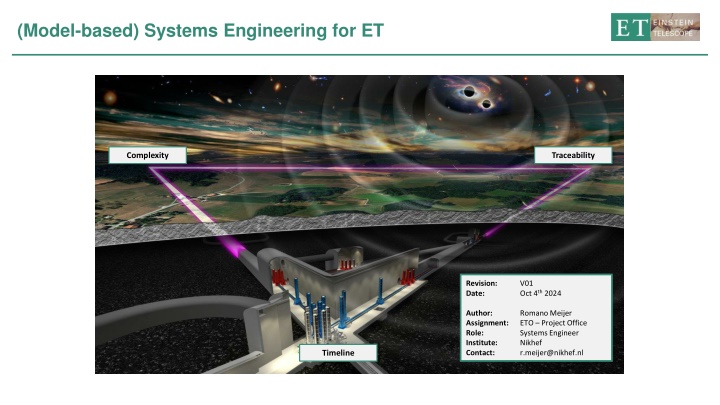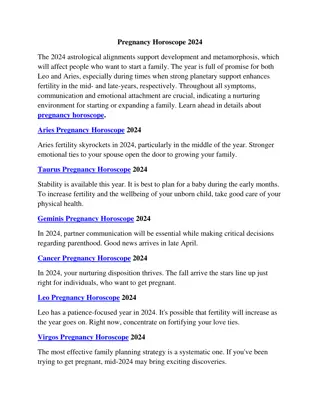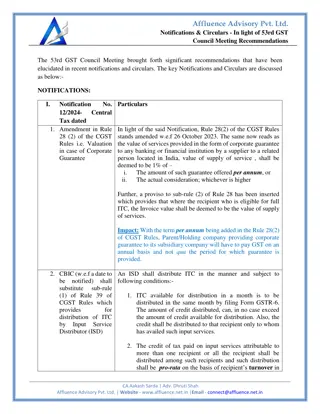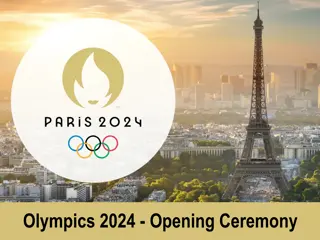
Engineering for ET Complexity Traceability Process
Dive into the model-based systems engineering process for managing time, complexity, and traceability in the context of the ET project. Explore high-level system decomposition, low-frequency interferometer layouts, node integration, and global functional systems. Uncover the intricacies of PBS and WBS structures in the context of HFI and ITF+SE integrated systems.
Download Presentation

Please find below an Image/Link to download the presentation.
The content on the website is provided AS IS for your information and personal use only. It may not be sold, licensed, or shared on other websites without obtaining consent from the author. If you encounter any issues during the download, it is possible that the publisher has removed the file from their server.
You are allowed to download the files provided on this website for personal or commercial use, subject to the condition that they are used lawfully. All files are the property of their respective owners.
The content on the website is provided AS IS for your information and personal use only. It may not be sold, licensed, or shared on other websites without obtaining consent from the author.
E N D
Presentation Transcript
(Model-based) Systems Engineering for ET Complexity Traceability Revision: Date: V01 Oct 4th 2024 Author: Assignment: Role: Institute: Contact: Romano Meijer ETO Project Office Systems Engineer Nikhef r.meijer@nikhef.nl Timeline
Systems Engineering process for ET Manage time, complexity and traceability ~ + 2
Lv 1: High-level system - starting the decomposition (PBS) PBS lv.1: ET Civil Infrastructure Noise (fundamental & technical) Electronics Data Service & Support Computing Infrastructure Environmental (clean air, HVAC) Site - Surface Technical Infrastructure Computing Infrastructure Site - Underground HFI LFI Data Processing z Water ingress Fluids x 3 Note: the PBS system decomposition in this presentation serves as an example and does not directly correspond to the latest PBS release (found here)
Lv 2: Low-frequency Interferometer (LFI) optical layout draft 4
Lv 2 (detail): LFI optical layout draft Lv 3: Node Low-Frequency Beam splitter (LBS) Split stabilized LF laser beam into two Fabry-Perot cavity arms 5
Lv 3: Nodes as integrated systems Single node contains complex subsystems (Lv 4): - Payload 5DoF controlled optical elements - Seismic Isolation System (SIS) Float' the payloads - Tower Vacuum System (TVS) Clean and quiet environment Lv 3: Node Low-Frequency Beam splitter (LBS) Split stabilized LF laser beam into two Fabry-Perot cavity arms But also systems serving global functions (Lv 5): - Stray light control (SLC) Reduce light (back)scattering - Wavefront sensing and control Control core optic curvature = Global functions cannot always be satisfied by individual nodes 6
Integrated systems and global functions PBS vs WBS PBS High-Frequency Interferometer (HFI) ITF+SE integrated system HF DVS HF RTCS HF LIS HF CITF HF ODS HF QNM Dist. Exp. Dist. Exp. SE integrated system HPRM HSEM HF MM HBS HITM HETM Distributed & Global functional system SIS PAY TVS LCS? Seismic Isolation Platform Filter Chain Core Optic PAY-SLC WSC Act Vessel base Vessel elements TVS-SLC WBS-only activities WBS High-Frequency Interferometer (HFI) ITF int+exp HF LIS HF CITF HF ODS HF QNM VAC HF RTCS SIS SLC WSC Optics OSD NE ISC WBS-only Exp. ITF int+exp ITF int+exp ITF int+exp ITF int+exp Dist. + loc. Exp Dist. Exp Loc. Exp Dist. Exp Dist. Exp Dist. Exp WBS-only Exp. WBS-only Exp. HSEM HF MM HBS HITM HETM HPRM Int Int Int Int Int Int 7
Steps taken towards Model-Based Systems Engineering - Draft of Systems Engineering and Requirement Management (RM) plans - Integrated-system based PBS proposal - Professional RM tool acquisition (Jama Connect) - This collaboration. Start: MBSE applied to a node? 8






















